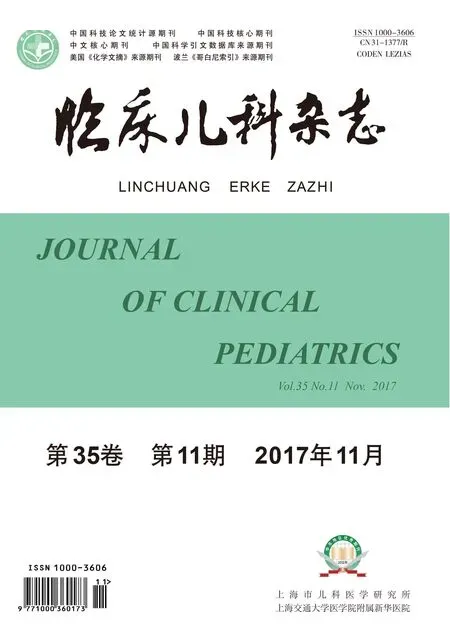早发癫痫性脑病遗传学病因研究进展
2017-11-29营综述束晓梅审校
李 营综述 束晓梅审校
遵义医学院附属医院儿科(贵州遵义 563003)
早发癫痫性脑病遗传学病因研究进展
李 营综述 束晓梅审校
遵义医学院附属医院儿科(贵州遵义 563003)
早发癫痫性脑病(EIEE)是一类由于频繁癫痫发作及痫性放电导致的严重脑疾病,主要特点为新生儿或婴儿早期起病,难以控制的癫痫发作及痫性放电,精神运动发育迟滞或倒退。近年来随着分子遗传学的进步,大量新的EIEE相关性基因突变被发现,使临床对EIEE的遗传学病因及病理生理机制有了更深入的理解。EIEE遗传学研究对了解发病机制、基因分型、个体化治疗、预后及遗传咨询具有重要意义。文章综述EIEE遗传学病因新进展。
早发癫痫性脑病; 遗传; 基因突变
早发癫痫性脑病(early infantile epileptic encephalopathy,EIEE)是一类由于难治性的癫痫发作及严重异常脑电导致的严重脑疾病,主要特征为新生儿或婴儿早期起病,难治性的癫痫发作及严重的脑电图异常放电,精神运动发育迟滞或倒退[1]。根据发病年龄、发作类型及脑电图等特点,2010年国际抗癫痫联盟(ILAE)对EIEE进行了命名及归类,主要有新生儿期发病的早发肌阵挛脑病、大田原综合征,婴儿早期发病的婴儿恶性游走性部分性发作、West综合征和Dravet综合征,以及维生素依赖性脑病等[1]。另外,临床上还可见到相当一部分EIEE不符合任何现已知的癫痫综合征,被称为非综合征性早发癫痫性脑病[2]。
EIEE病因主要包括先天性,脑结构异常和代谢障碍、遗传因素;获得性,围产期脑损伤及颅内感染;及病因未明,约占1/3[3]。近年来,随着基因诊断水平提高,对EIEE遗传学病因和病理生理机制有了更加深入了解。2011年美国国立神经病及中风研究所建立的Epilepsy 4000计划和癫痫表型组/基因组研究,通过测序发现近100个基因可能携带致痫突变[4]。这些突变被报道与自闭症等神经发育疾病相关,因此有专家提出“获得性或遗传性脑病伴癫痫发作(genetic or acquired encephalopathy with epilepsy)”的概念[5,6]。以往的癫痫遗传学研究主要集中在离子通道基因,随着高通量测序特别是全基因组外显子测序(whole genome sequencing,WES)的临床应用,发现许多参与神经系统发育的非离子通道基因也与EIEE有关,由于基因功能的差异,导致EIEE的病因机制也大相径庭[7]。本文对几种EIEE及其遗传病因进展综述如下。
1 大田原综合征
大田原综合征(Ohtahara syndrome,OS)多在新生儿期起病,典型表现为强直痉挛发作、精神运动发育落后、持续的爆发抑制脑电图表现。约75%的OS在2~6个月可转变为West综合征,1~3岁演变为Lennox-Gastaut综合征。OS与围产期脑损伤、先天性脑结构异常及代谢障碍有关[8]。近年来发现越来越多的基因突变与OS相关,最常见的是影响神经发育及递质释放的基因ARX、STXBP1,离子通道基因SCN2A、GABRA1,及编码谷氨酸转运体的基因SLC25A22[8-12]。ARX及STXBP1突变所导致的大田原综合征有转变为West综合征倾向[8]。ARX突变常发现伴有积水性无脑、无脑回畸形或胼胝体发育不全等脑发育畸形[13],基因突变是先天性脑发育畸形或代谢障碍的重要原因之一。EIEE伴先天性代谢障碍以及脑发育畸形时不能除外存在潜在遗传病因的可能,甚至二者共同参与了难治性的癫痫发作和脑病的发生。
2 早期肌阵挛癫痫脑病
早期肌阵挛癫痫脑病(Early myoclonic encephalo-pathy,EME)与OS有相似之处,均在新生儿期起病、EEG呈爆发抑制图形。但是,两者的发作类型及病因不同。EME表现为游走性或部分性肌阵挛发作[8],主要与非酮症高甘氨酸血症、甲基丙二酸血症、Zellweger综合征等先天性代谢障碍有关,部分先天性代谢障碍已明确遗传病因,Belcastro等[14]发现非酮症高甘氨酸血症与GLDC、AMT、GCSH基因突变有关。Cohen等[15]报道SLC25A22基因错义突变可导致EME。
3 婴儿恶性游走性部分性发作
婴儿恶性游走性部分性发作(malignant migrating partial seizures in infancy,MMPSI)多于生后6个月内发病,起病前发育可正常。临床表现为频繁的游走性部分性发作,有转变为OS和West综合征的倾向。KCNT突变是MMPSI最常见报道的遗传病因[16],部分性发作及局灶性放电是KCNT1突变表型谱的电-临床特征[17,18]。另外,与MMPSI相关的基因突变还包括SCN1A、SCN8A、PLCB1、SLC25A22等[19-22]。
4 West综合征
又称婴儿痉挛症(infantile spasms,IS),是最常见的婴儿期癫痫性脑病,发病率约为1/3200。典型表现为成串的癫痫性痉挛发作、脑电图高度失律、精神运动发育迟滞或倒退。40%存在先天性脑结构异常及代谢障碍、神经皮肤综合征(结节性硬化最多见)、缺血缺氧性脑病等先天性或围产期病因[23]。其遗传病因与X染色体上的ARX、CDKL5、ALG13基因以及常染色体上的STXBP1、SCN1A、DNM1、SPTAN1等基因突变有关[24-26]。SPTAN1突变常伴有脑白质髓鞘化不良。此外,拷贝数变异也可导致West综合征[23]。
5 Dravet综合征
Dravet综合征(Dravet syndrome,DS)多1岁内起病,常为热诱发的全身或半侧阵挛或强直阵挛发作,特点是发作持续时间长,常出现癫痫持续状态,随后可合并肌阵挛、不典型失神及部分性发作等多种发作类型,发作的热敏感性终生存在[27]。70%以上的Dravet综合征可检测到SCN1A突变(新生突变),其他离子通道基因如SCN1B、SCN2A及GABARG2突变也与之有关[28-30]。另外,SCN8A、PCDH19突变的临床表型和 Dravet综合征类似[31,32]。
6 维生素反应性癫痫脑病
少数EIEE属于维生素或维生素衍生物反应性癫痫,即维生素或其衍生物可能阻止这一进展性病程从而改善预后,并且癫痫脑病的严重程度与治疗时机有关,故早期识别非常重要。这类疾病主要有吡哆醇依赖性癫痫、叶酸缺乏症、维生素B12缺乏症及磷酸吡哆醛依赖性癫痫等(表1)。其临床多表现为新生儿期或婴儿早期起病,难治性的癫痫及非特异性脑电图异常,且发作形式多样,伴不同程度的神经系统发育迟滞[33,34],相关的遗传学病因见表1。

表1 维生素反应性癫痫脑病的临床、脑电图及治疗
7 非综合征性早发癫痫性脑病
大多数的EIEE并未被ILAE命名及分类。以往EIEE的致病基因检出率不到10%,随着靶向二代测序的应用,超过25%的EIEE已明确了突变基因[3]。EIEE具有遗传和表型异质性,同一基因突变可导致多种临床表型。某些基因表型谱可能具有独特的电临床特点,如CDKL5突变相关性癫痫脑病(EIEE2)按发作类型不同可分三个时期,分别以强直发作、痉挛发作及肌阵挛为主[35];ARX突变多表现为婴儿痉挛、肌张力障碍、自闭症等;STXBP1突变相关性EIEE多伴有运动障碍[16];CHD2突变表型均有光敏性[36]。目前,将EIEE根据基因分型,已从EIEE1型更新至EIEE47型,特定基因的表型谱仍在不断丰富,见表2。总之,EIEE的遗传学病因研究对其发病机制、基因分型、个体化治疗、预后及遗传咨询具有重要意义。

表2 按突变基因EIEE分型 (参考OMIM,2017.01.01)
[1]Berg AT,Berkovic SF,Brodie MJ,et al.Revised terminology and concepts for organization of seizures and epilepsies:report of the ILAE Commission on Classification and Terminology,2005-2009 [J].Epilepsia,2010,51(4): 676-685.
[2]Kwong AK,Ho AC,Fung CW,et al.Analysis of mutations in 7 genes associated with neuronal excitability and synaptic transmission in a cohort of children with non-syndromic infantile epileptic encephalopathy [J].PloS one,2015,10(5):e0126446.
[3]Mercimek-Mahmutoglu S,Patel J,Cordeiro D,et al.Diagnostic yield of genetic testing in epileptic encephalopathy in childhood [J].Epilepsia,2015,56(5): 707-716.
[4]Epi4K Consortium.Epi4K: gene discovery in 4,000 genomes[J].Epilepsia,2012,53(8): 1457-1467.
[5]Korff CM,Brunklaus A,Zuberi SM.Epileptic activity is a surrogate for an underlying etiology and stopping the activity has a limited impact on developmental outcome [J].Epilepsia,2015,56(10): 1477-1481.
[6]Auvin S,Cilio MR,Vezzani A.Current understanding and neurobiology of epileptic encephalopathies [J].Neurobiol Dis,2016,92(Pt A): 72-89.
[7]McTague A,Howell KB,Cross JH,et al.The genetic landscape of the epileptic encephalopathies of infancy and childhood [J].Lancet Neurol,2016,15(3): 304-316.
[8]Pavone P,Spalice A,Polizzi A,et al.Ohtahara syndrome with emphasis on recent genetic discovery [J].Brain Dev,2012,34(6): 459-468.
[9]Kato M,Koyama N,Ohta M,et al.Frameshift mutations of the ARX gene in familial Ohtahara syndrome [J].Epilepsia,2010,51(9): 1679-1684.
[10]Tso WW,Kwong AK,Fung CW,et al.Folinic acid responsive epilepsy in Ohtahara syndrome caused by STXBP1 mutation[J].Pediatr Neurol,2014,50(2): 177-180.
[11]Nakamura K,Kato M,Osaka H,et al.Clinical spectrum of SCN2A mutations expanding to Ohtahara syndrome [J].Neurology,2013,81(11): 992-998.
[12]Johannesen K,Marini C,Pfeffer S,et al.Phenotypic spectrum of GABRA1: from generalized epilepsies to severe epileptic encephalopathies [J].Neurology,2016,87(11): 1140-1151.
[13]Suri M.The phenotypic spectrum of ARX mutations [J].Dev Med Child Neurol,2005,47(2): 133-137.
[14]Belcastro V,Barbarini M,Barca S,et al.A novel AMT gene mutation in a newborn with nonketotic hyperglycinemia and early myoclonic encephalopathy [J].Eur J Paediatr Neurol,2016,20(1): 192-195.
[15]Cohen R,Basel-Vanagaite L,Goldberg-Stern H,et al.Two siblings with early infantile myoclonic encephalopathy due to mutation in the gene encoding mitochondrial glutamate/H+symporter SLC25A22 [J].Eur J Paediatr Neurol,2014,18(6):801-805.
[16]McTague A,Appleton R,Avula S,et al.Migrating partial seizures of infancy: expansion of the electroclinical,radiological and pathological disease spectrum [J].Brain ,2013,136(Pt 5): 1578-1591.
[17]Barcia G,Fleming MR,Deligniere A,et al.De novo gainof-function KCNT1 channel mutations cause malignant migrating partial seizures of infancy [J].Nat Genet,2012,44(11): 1255-1259.
[18]Ohba C,Kato M,Takahashi N,et al.De novo KCNT1 mutations in early-onset epileptic encephalopathy [J].Epilepsia,2015,56(9): e121-128.
[19]Carranza Rojo D,Hamiwka L,McMahon JM,et al.De novo SCN1A mutations in migrating partial seizures of infancy [J].Neurology,2011,77(4): 380-383.
[20]Ohba C,Kato M,Takahashi S,et al.Early onset epileptic encephalopathy caused by de novo SCN8A mutations [J].Epilepsia,2014,55(7): 994-1000.
[21]Ngoh A,McTague A,Wentzensen IM,et al.Severe infantile epileptic encephalopathy due to mutations in PLCB1:expansion of the genotypic and phenotypic disease spectrum[J].Dev Med Child Neurol,2014,56(11): 1124-1128.
[22]Molinari F,Kaminska A,Fiermonte G,et al.Mutations in the mitochondrial glutamate carrier SLC25A22 in neonatal epileptic encephalopathy with suppression bursts [J].Clin Genet,2009,76(2): 188-194.
[23]Michaud JL,Lachance M,Hamdan FF,et al.The genetic landscape of infantile spasms [J].Hum Mol Genet,2014,23(18): 4846-4858.
[24]Ma C,Zhang Y,Li YQ,et al.The Role of PPARgamma in Advanced Glycation End Products-Induced Inflammatory Response in Human Chondrocytes [J].PloS one,2015,10(5):e0125776.
[25]Allen AS,Berkovic SF,Cossette P,et al.De novo mutations in epileptic encephalopathies [J].Nature,2013,501(7466):217-221.
[26]Kato M,Das S,Petras K,et al.Polyalanine expansion of ARX associated with cryptogenic West syndrome [J].Neurology,2003,61(2): 267-276.
[27]Battaglia D,Ricci D,Chieffo D,et al.Outlining a core neuropsychological phenotype for Dravet syndrome [J].Epilepsy Res,2016,120: 91-97.
[28]Lossin C,Shi X,Rogawski MA,et al.Compromised function in the Na(v)1.2 Dravet syndrome mutation R1312T [J].Neurobiol Dis,2012,47(3): 378-384.
[29]Nabbout R,Gennaro E,Dalla Bernardina B,et al.Spectrum of SCN1A mutations in severe myoclonic epilepsy of infancy[J].Neurology,2003,60(12): 1961-1967.
[30]Harkin LA,Bowser DN,Dibbens LM,et al.Truncation of the GABA(A)-receptor gamma2 subunit in a family with generalized epilepsy with febrile seizures plus [J].Am J Hum Genet,2002,70(2): 530-536.
[31]Thiffault I,Farrow E,Smith L,et al.PCDH19-related epileptic encephalopathy in a male mosaic for a truncating variant [J].Am J Med Genet A,2016,170(6): 1585-1589.
[32]Trivisano M,Pietrafusa N,Ciommo Vd,et al.PCDH19-related epilepsy and Dravet Syndrome: Face-off between two early-onset epilepsies with fever sensitivity [J].Epilepsy Res,2016,125: 32-36.
[33]Veerapandiyan A,Winchester SA,Gallentine WB,et al.Electroencephalographic and seizure manifestations of pyridoxal 5'-phosphate-dependent epilepsy [J].Epilepsy Behav,2011,20(3): 494-501.
[34]Pérez-Dueñas B,Toma C,Ormazabal A,et al.Progressive ataxia and myoclonic epilepsy in a patient with a homozygous mutation in the FOLR1 gene [J].J Inherit Metab Dis,2010,33(6): 795-802.
[35]Zhao Y,Zhang X,Bao X,et al.Clinical features and gene mutational spectrum of CDKL5-related diseases in a cohort of Chinese patients [J].BMC Med Genet,2014,15: 24.
[36]Suls A,Jaehn JA,Kecskés A,et al.De novo loss-of-function mutations in CHD2 cause a fever-sensitive myoclonic epileptic encephalopathy sharing features with Dravet syndrome [J].Am J Hum Genet,2013,93(5): 967-975.
2017-01-11)
(本文编辑:梁 华)
Genetic studies in early infantile epileptic encephalopathy
Reviewer: LI Ying,Reviser: SHU Xiaomei (Department of Pediatrics,Af fi liated Hospital of Zunyi Medical College,Zunyi 563003,Guizhou,China)
Early infantile epileptic encephalopathy is a group of disorders affecting children at early stages of infancy,which is characterized by frequent seizures,epileptiform activity on EEG,and developmental retardation or regression.As genetic testing methods advance,an increasing number of novel genetic causes have been uncovered,the genetic etiologies and physiopathologic mechanism of these epileptic syndromes are now better understood.The purpose of this article is to review the progresses in the fi eld of genetic studies in some early infantile epileptic encephalopathies.
Early infantile epileptic encephalopathy; Genetics; Mutation
10.3969/j.issn.1000-3606.2017.11.016
